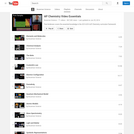
Paul Anderson's video playlist of videos that can be used in a AP Chemistry Video Essentials class
- Subject:
- Chemistry
- Physical Science
- Material Type:
- Lecture
- Provider:
- Bozeman Science
- Date Added:
- 11/23/2016

Paul Anderson's video playlist of videos that can be used in a AP Chemistry Video Essentials class

A modified version of a Chalk Talk routine in which the educator provides a prompt for students to put forth ideas, questions, and further develop ideas of others in an effort to advance understanding in relation to a topic.
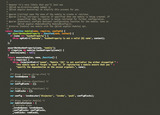
This activity utilizes a Claim-Support-Question framework that allows students to draw on prior knowledge, investigation, and questioning. Designed to be placed within a Java context of enhancing object-oriented programming classes using interfaceses, students will analyze, implement, and support claims regarding three separate interfaces while moving between analysis and program implementation.

This activity is utilized as a method for students to commuincate their current learning, progress their understanding, and then reflect on their current understanding of a topic and share what they now think and the connections they have built.
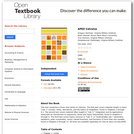
APEX Calculus is a calculus textbook written for traditional college/university calculus courses. It has the look and feel of the calculus book you likely use right now (Stewart, Thomas & Finney, etc.). The explanations of new concepts is clear, written for someone who does not yet know calculus. Each section ends with an exercise set with ample problems to practice & test skills (odd answers are in the back).
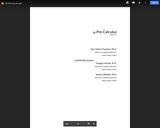
This text was written as a prequel to the APEXCalculus series, a three–volume series on Calculus. This text is not intended to fully prepare students with all of the mathematical knowledge they need to tackle Calculus, rather it is designed to review mathematical concepts that are often stumbling blocks in the Calculus sequence. It starts basic and builds to more complex topics. This text is written so that each section and topic largely stands on its own, making it a good resource for students in Calculus who are struggling with the supporting mathemathics found in Calculus courses. The topics were chosen based on experience; several instructors in the Applied Mathemathics Department at the Virginia Military Institute (VMI) compiled a list of topics that Calculus students commonly struggle with, giving the focus of this text. This allows for a more focused approach; at first glance one of the obvious differences from a standard Pre-Calculus text is its size.

This course contains five projects, plus a course introduction and course closure, that are organized around the following question: “How can we rethink our use of the world’s resources?” Each project involves investigations of sustainability that help contextualize the content required by the new College Board course framework.
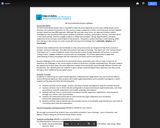
This AP Environmental Science class is intended to meet the same objectives as a first-year college-based course.
However, the method of instruction for this course is unique compared to similar courses because we have adopted
a project-based learning (PBL) approach. Although PBL may take many forms, our approach involves student
investigations and simulations that require students to think like scientists, policymakers, farmers, and other adults
in real-world settings. Teachers engage students in collaborative problem solving, argumentation, and deep
exploration of the concepts and principles of the discipline. The goal for student learning is understanding rather
than relying on rote memory to create meaningful learning and knowledge that is actionable, adaptive, and
transferable.

Paul Anderson playlist of videos that can be used in an AP Environmental Science Class
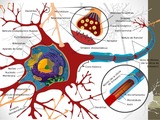
Anatomy and Physiology Lab I slide decks created by Steven Lee M.S. Pathology, FTCC. The PowerPoints include labeled body images to assist students in identifying body parts. Nicole Shaw is only responsible for assisting Steven with licensing his work under an open license and uploading content to the Commons.

Anatomy and Physiology Lab I slide decks created by Steven Lee M.S. Pathology, FTCC. The PowerPoints include labeled body images to assist students in identifying body parts. Nicole Shaw is only responsible for assisting Steven with licensing his work under an open license and uploading content to the Commons.

Estudo de eficácia da aplicação de maquete didática, simulando o comportamento de diferentes tipos de microplásticos em distintos ambientes aquáticos, aplicado à estudantes do 7° ano de escola pública em Belém-PA.

This textbook introduces students to the application methods of control charts to improve quality in health care. The textbook is written to be accessible to any student in the areas of health information management, health care informatics, and health care industrial engineering. Having a basic background in statistics would be beneficial, but such training is not a prerequisite to understanding how to apply the techniques discussed here. Several How-To sections are included to demonstrate the implementation of the given control charts using software such as Minitab and Excel. Additionally, samples of a Python code are included and can directly be accessed in a Jupyter Notebook at https://github.com/JeromeNN/Applications-Control-Charts-Quality-Improvement-Health-Care
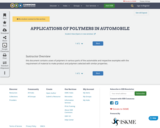
this document contains usses of polymers in various parts of the automobile and respective examples with the requirement of material to make product and polymers selected with similar properties.
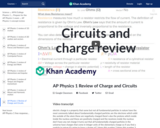
In this video David quickly explains each charge and circuit concept and does a sample question for each one. Created by David SantoPietro.
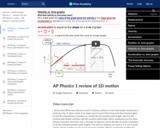
In this video David rapidly explains all the concepts in 1D motion and also quickly solves a sample problem for each concept. Keep an eye on the side scroll see how far along you've made it in the review video. Created by David SantoPietro.
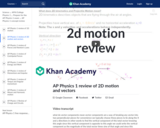
In this video David quickly explains each 2D motion concept and does a quick example problem for each concept. Keep an eye on the scroll to the right to see where you are in the review. Created by David SantoPietro.
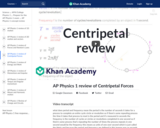
In this video David explains each concept for centripetal motion and solves an example problem for each concept. Created by David SantoPietro.
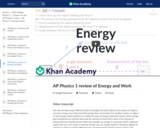
In this video David explains the concepts in Work and Energy and does an example problem for each concept. Link for document: https://www.dropbox.com/s/t1w6xlnkozzel17/Energy%20review.pdf?dl=0. Created by David SantoPietro.
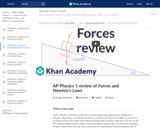
In this video David quickly explains each concept behind Forces and Newton's Laws and does a sample problem for each concept. Keep an eye on the scroll to the right to see how far along you've made it in the review. Created by David SantoPietro.